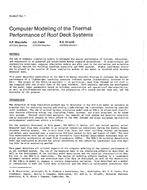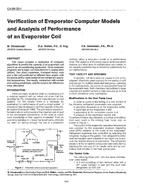This report provides information done under ASHRAE RP-392. The project objectives were: 1) To measure data for boiling in tube bundles using several different refrigerants and tube geometries, and 2) To develop a correlation for prediction of the data. An experimental apparatus was built to provide independent control of heat flux, vapor quality and mass velocity in order to simulate flooded refrigerant evaporators. Tube bank data are reported for R-ll, R-123, and R-134a at saturation temperatures of 4.4 C and 26.7 C. The tube banks have staggered bundle layout and a pitch-to-diameter ratio of 1.25.
The tubes tested include GEWA-SE, Turbo-B and integral finned tubes (26 fins/inch). The data span heat fluxes of 15 to 47 kW/m2, vapor qualities of 0.05 to 0.9, and mass velocities of 8 to 26 kg/m2-s. The data include both convective vaporization and pool boiling.
The Turbo-B tubes show no effect of forced convection. The GEWA-SE tubes exhibit effect of forced convection only for the R-ll and R-123 data at low heat fluxes. The R-ll data on integral finned tubes show strong effects of forced convection. This effect is more pronounced at low heat fluxes and at 4.4 C saturation temperature. A suppression factor of unity is proposed for enhanced tubes. The R-ll and R-123 data on the Turbo-B tube bank, and the R-134a data on the GEWA-SE tube bank support this proposal.
The data were correlated using an “asymptotic” convection vaporization model. This model accounts for the effect of nucleate boiling and convective evaporation. The asymptotic model is proposed as a generalized model for both, in-tube and tube bank situations. A suppression factor of unity is assumed for integral finned tubes. The model correlates 84% of the data within ±20%.
Product Details
- Published:
- 1989
- Number of Pages:
- 162
- File Size:
- 1 file , 2.7 MB
- Product Code(s):
- D-RP-392


